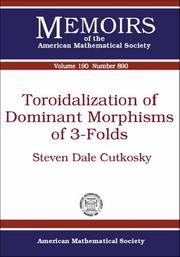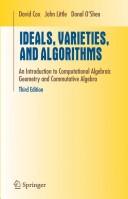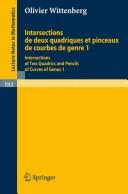| Listing 1 - 7 of 7 |
Sort by
|
Dissertation
Year: 2007 Publisher: [S.l.]: [chez l'auteur],
Abstract | Keywords | Export | Availability | Bookmark
 Loading...
Loading...Choose an application
- Reference Manager
- EndNote
- RefWorks (Direct export to RefWorks)
Hodge theory. --- Hodge, Théorie de --- Geometrie algebrique --- Topologie algebrique --- Espaces fibres --- Geometrie algebrique --- Topologie algebrique --- Espaces fibres
Book
ISSN: 03031179 ISBN: 9782856292440 9782856292457 Year: 2007 Publisher: Paris Société mathématique de France
Abstract | Keywords | Export | Availability | Bookmark
 Loading...
Loading...Choose an application
- Reference Manager
- EndNote
- RefWorks (Direct export to RefWorks)
Book
ISSN: 0249633X ISBN: 9782856292518 Year: 2007 Publisher: Paris : Société Mathématique de France,
Abstract | Keywords | Export | Availability | Bookmark
 Loading...
Loading...Choose an application
- Reference Manager
- EndNote
- RefWorks (Direct export to RefWorks)

ISBN: 9780821839980 Year: 2007 Publisher: Providence American Mathematical Society
Abstract | Keywords | Export | Availability | Bookmark
 Loading...
Loading...Choose an application
- Reference Manager
- EndNote
- RefWorks (Direct export to RefWorks)
Algebraic geometry --- 51 <082.1> --- Mathematics--Series --- Geometry, Algebraic. --- Morphisms (Mathematics) --- Algebraic varieties. --- Commutative algebra. --- Géométrie algébrique. --- Morphismes (mathématiques) --- Variétés algébriques. --- Algèbres commutatives. --- Algebraic varieties --- Commutative algebra --- Geometry, Algebraic --- Categories (Mathematics) --- Set theory --- Geometry --- Algebra --- Varieties, Algebraic --- Linear algebraic groups

ISBN: 9780521709835 0521709830 9780511800443 0511800444 9781107367920 1107367921 9781107363014 1107363012 1316087662 1107369843 1299409172 1107365465 Year: 2007 Volume: 345 Publisher: Cambridge : Cambridge University Press,
Abstract | Keywords | Export | Availability | Bookmark
 Loading...
Loading...Choose an application
- Reference Manager
- EndNote
- RefWorks (Direct export to RefWorks)
This textbook, for an undergraduate course in modern algebraic geometry, recognizes that the typical undergraduate curriculum contains a great deal of analysis and, by contrast, little algebra. Because of this imbalance, it seems most natural to present algebraic geometry by highlighting the way it connects algebra and analysis; the average student will probably be more familiar and more comfortable with the analytic component. The book therefore focuses on Serre's GAGA theorem, which perhaps best encapsulates the link between algebra and analysis. GAGA provides the unifying theme of the book: we develop enough of the modern machinery of algebraic geometry to be able to give an essentially complete proof, at a level accessible to undergraduates throughout. The book is based on a course which the author has taught, twice, at the Australian National University.
Geometry, Algebraic --- Geometry, Analytic --- Géométrie algébrique --- Géométrie analytique --- Géométrie algébrique --- Géométrie analytique --- Geometry, Algebraic. --- Geometry, Analytic. --- Analytical geometry --- Algebra --- Conic sections --- Algebraic geometry --- Geometry --- Graphic methods

ISBN: 0387356509 1441922571 0387356517 9780387356501 9780387356518 Year: 2007 Publisher: New York : Springer,
Abstract | Keywords | Export | Availability | Bookmark
 Loading...
Loading...Choose an application
- Reference Manager
- EndNote
- RefWorks (Direct export to RefWorks)
Algebraic Geometry is the study of systems of polynomial equations in one or more variables, asking such questions as: Does the system have finitely many solutions, and if so how can one find them? And if there are infinitely many solutions, how can they be described and manipulated? The solutions of a system of polynomial equations form a geometric object called a variety; the corresponding algebraic object is an ideal. There is a close relationship between ideals and varieties which reveals the intimate link between algebra and geometry. Written at a level appropriate to undergraduates, this book covers such topics as the Hilbert Basis Theorem, the Nullstellensatz, invariant theory, projective geometry, and dimension theory. The algorithms to answer questions such as those posed above are an important part of algebraic geometry. Although the algorithmic roots of algebraic geometry are old, it is only in the last forty years that computational methods have regained their earlier prominence. New algorithms, coupled with the power of fast computers, have led to both theoretical advances and interesting applications, for example in robotics and in geometric theorem proving. In addition to enhancing the text of the second edition, with over 200 pages reflecting changes to enhance clarity and correctness, this third edition of Ideals, Varieties and Algorithms includes: A significantly updated section on Maple in Appendix C Updated information on AXIOM, CoCoA, Macaulay 2, Magma, Mathematica and SINGULAR A shorter proof of the Extension Theorem presented in Section 6 of Chapter 3 From the 2nd Edition: "I consider the book to be wonderful. ... The exposition is very clear, there are many helpful pictures, and there are a great many instructive exercises, some quite challenging ... offers the heart and soul of modern commutative and algebraic geometry." -The American Mathematical Monthly
Geometry, Algebraic --- Commutative algebra --- Géométrie algébrique --- Algèbres commutatives --- Data processing --- Informatique --- EPUB-LIV-FT LIVMATHE SPRINGER-B --- Algèbres commutatives --- Algorithmes --- Algorithms --- Algèbres commutatives. --- Algorithmes. --- Géométrie algébrique.

ISBN: 9783540691372 3540691375 3540691413 Year: 2007 Publisher: Berlin, Heidelberg : Springer Berlin Heidelberg : Imprint: Springer,
Abstract | Keywords | Export | Availability | Bookmark
 Loading...
Loading...Choose an application
- Reference Manager
- EndNote
- RefWorks (Direct export to RefWorks)
Cet ouvrage est consacré à l'arithmétique des surfaces fibrées en courbes de genre 1 au-dessus de la droite projective, et à l'arithmétique des intersections de deux quadriques dans l'espace projectif. Swinnerton-Dyer introduisit en 1993 une technique permettant d'étudier les points rationnels des pinceaux de courbes de genre 1. La première moitié de l'ouvrage reprend et développe cette technique ainsi que ses généralisations ultérieures. La seconde moitié, qui repose sur la première, porte sur les surfaces de del Pezzo de degré 4 et sur les intersections de deux quadriques de dimension supérieure; les résultats annoncés dans [C. R. Math. Acad. Sci. Paris 342 (2006), no. 4, 223--227] y sont démontrés. This research monograph focuses on the arithmetic, over number fields, of surfaces fibred into curves of genus 1 over the projective line, and of intersections of two quadrics in projective space. The first half contains a complete account of the technique initiated by Swinnerton-Dyer in 1993 for studying rational points on pencils of curves of genus 1, while incorporating and generalising most of its subsequent refinements. The second half, which builds upon the first, is devoted to quartic del Pezzo surfaces and higher-dimensional intersections of two quadrics. It culminates in the proof of the results announced in [C. R. Math. Acad. Sci. Paris 342 (2006), no. 4, 223--227].
Algebraïsche meetkunde. --- Diofantische analyse. --- Quartic surfaces. --- Quadrics. --- Matrix pencils. --- Geometry, Algebraic. --- Surfaces quartiques --- Géométrie algébrique --- Electronic books. -- local. --- Geometry. --- Algebra --- Geometry --- Mathematics --- Physical Sciences & Mathematics --- Algebraic geometry --- Mathematics. --- Algebraic geometry. --- Number theory. --- Number Theory. --- Algebraic Geometry. --- Number study --- Numbers, Theory of --- Math --- Science --- Euclid's Elements --- Geometry, algebraic.
| Listing 1 - 7 of 7 |
Sort by
|

 Search
Search Feedback
Feedback About
About Help
Help News
News